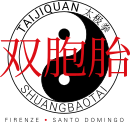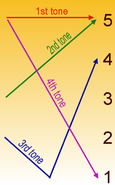




anti-fascist
anti-racist

|
    |
anti-sexist anti-fascist anti-racist |

The Chinese language is tonal. Each tone is indicated by a diacritical mark above a non-medial vowel.
| The first tone | ā ō ē ī ū ǖ | loud and continuous | ||
| The second tone | á ó é í ú ǘ | rising | ||
| The third tone | ǎ ǒ ě ǐ ǔ ǚ | descending, then rising | ||
| The fourth tone | à ò è ì ù ǜ | descending, brief | ||
| The fifth tone | a o e i u ü | neutral |
A common convention to ease of inputting with a normal keybord is to postfix the individual syllables with a digit representing their tone (e.g., "tóng" (tong with the rising tone) is written "tong2"). The digit is numbered as the order listed above, except the "fifth tone", which, in addition to being numbered 5, is also either not numbered or numbered zero
The pinyin vowels are ordered as a, o, e, i, u, and ü. Generally, the tone mark is placed on the vowel that first appears in the order mentioned. Liú (六, six) is a superficial exception whose true pronunciation is lióu. And since o precedes i, óu (contracted to ú) is marked
This article is licensed under the GNU Free Documentation License. It uses material from the Wikipedia article "Pinyin".